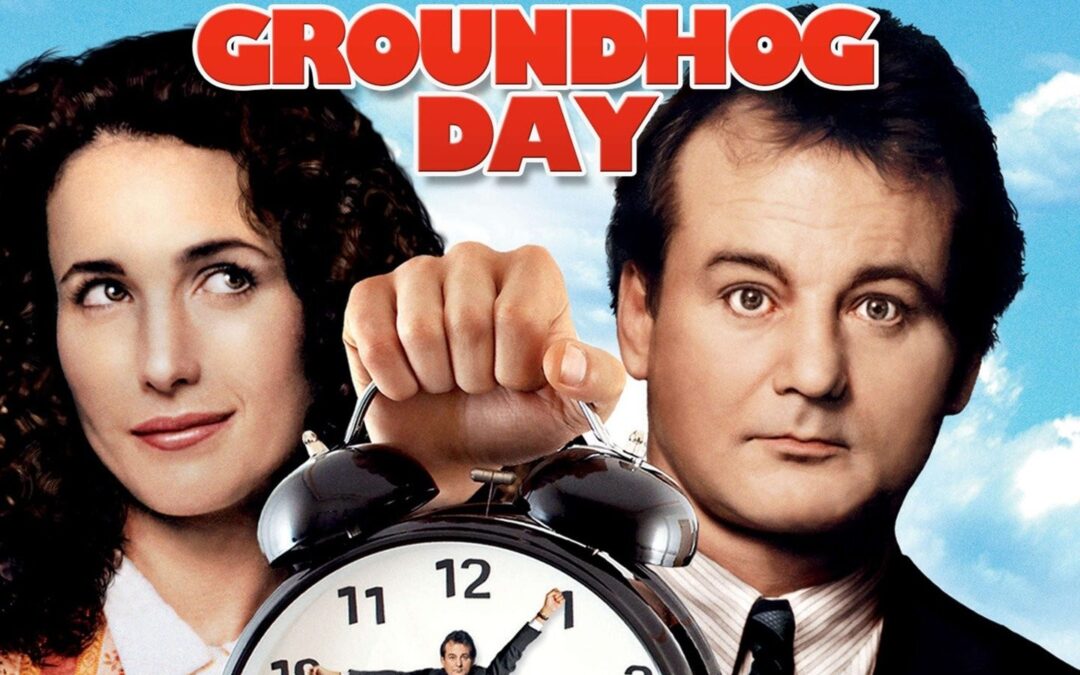In the 1993 film, “Groundhog Day,” Bill Murray plays Phil, a local weatherman who is obnoxious, self-centered, and entitled. It’s February 2nd, and he must cover the Groundhog Day celebration in Punxsutawney, PA. “Punxsutawney Phil,” the groundhog, will predict how long winter will remain. Phil and his crew get stranded there by a winter storm and must spend the night. He wakes up the next morning, and it’s “Groundhog Day” all over again. In fact, every day from there on out is Groundhog Day. He meets the same people, the same things happen, and so begins a slow descent into desperation.
At first, it’s kind of fun. He eats too much, drinks too much, seduces women, and takes all kinds of physical risks with no permanent consequences. He wakes up the next morning, and it’s Groundhog Day all over again. Over time, he begins to notice that there is no continuity in his interactions with others—he is not connected to them. Each day he must go through extraordinary efforts to re-establish his connection to them, but always with the goal of self-gratification. He sets his sights on seducing his producer, played by Andie McDowell, and fails repeatedly. He soon wearies of the endless boredom and desperate sameness of his life. He becomes suicidal and tries to take his life several times. No matter what he does, he cannot kill himself. He awakens the next morning, and it starts all over again.
One of his ploys in attempting to seduce his producer is to learn about everything she is interested in. This also fails but changes his course somewhat, and he begins to study music and ice sculpture for his own edification. He experiments with service to others and is very moved by the death of a homeless man whom he has tried to support and nourish that day. He recognizes the impermanence of life and the inevitability of death for everyone—except himself. He begins to use his talents to perform selfless acts of service, which eventually breaks the spell of Groundhog Day. He returns to the status of a mortal man and, of course, gets the girl.
He has had a spiritual awakening of the educational variety, which has resulted in his freedom. A series of experiences created a moment of clarity that put him on a path toward a different view of life. This is precisely the goal of 12-step recovery, as it is contained in the 12th step: “Having had a spiritual awakening as a result of these steps, we tried to carry this message to others and to practice these principles in all of our affairs.” Addiction Medicine is one of the few areas in medicine where a “spiritual awakening” is an indicated form of treatment.
Alcoholism and addiction are real examples of “Groundhog Day.” The disease progresses through three phases: fun, fun with some problems, and just problems. Some patients begin to seek treatment in phase 2 if they are lucky, but most don’t come into treatment until they are solidly in phase 3. By then, their lives are a daily round of chasing booze or dope, lying, cheating, stealing, manipulating, and committing criminal acts to get the money to do the dope. The first thing they lose is their dignity and self-respect. As the disease progresses, they have increasing problems in one or more of the following areas: romance, finance, health, family, work, or the legal system. They become increasingly isolated by their use of the substance—they definitely don’t drink or drug like other people and they can’t have “just one or two”; their shame over the use of drugs or alcohol; and their increasing isolation from those who have been hurt by their conduct. They become desperate.
The antidote to their desperation is hope, and hope is an acronym; it stands for Hearing Other People’s Experiences. Their profound loneliness is transformed into a connection with those in the 12-step program who have done what they did. Their peers have gotten sober and now lead functional lives—free from the domination of alcohol and drugs. There is a cost, however, and that is hard work. They must work the 12 steps.
The 12 steps can be arbitrarily divided into four phases: steps 1 through 3 involve the recognition that their “drug of no choice” (once they start, they can’t stop) is a malignant higher power, and then they define a benign higher power that can displace the malignant higher power and restore them to sanity; steps 4 and 5 are confession; steps 8 and 9 are restitution; and steps 10 through 12 are helping others by continuing to practice the tenets of the program. The above steps are the action steps and require work on the part of the patient. Steps 6 and 7, however, are the mystical steps of the program, which only require the patient to become willing to have the higher power remove his defects of character.
For the most part, alcoholics and addicts don’t get a lot of good press. The evening news has a credo, and that is: “If it bleeds, it leads.” Obviously, drinking and drugging can lead to wholesale destruction, but a lot of people don’t get to see what I get to see: peace of mind, a functional life, restoration of family ties, and a release from “Groundhog Day.” All of which is contingent upon the maintenance of the patient’s spiritual awakening.
Special thanks to my mentor, Bob F., for suggesting that I watch “Groundhog Day” again as he feels it is the most spiritual movie he has ever seen.

